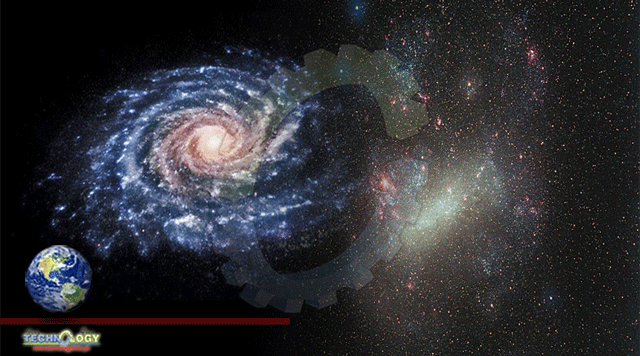Astronomers have known for years that galaxies are cannibalistic. Massive galaxies like our own Milky Way have gained mass by absorbing smaller neighbours.

Now it looks like smaller galaxies like the Large Magellanic Cloud have also feasted on smaller neighbours.
Astronomers have uncovered evidence that the Large Magellanic Cloud (LMC), a dwarf satellite galaxy of the Milky Way, has absorbed globular clusters. Globular clusters aren’t quite galaxies; they’re spherical clusters of thousands or even millions of stars, and they’re the largest and most massive type of clusters. They’re older and usually have lower metallicity than open clusters. Astronomers think that globular clusters can remain partly coherent, even after being absorbed by a larger galaxy like the LMC.
A group of Dutch and Italian astronomers have published a paper presenting their evidence that the LMC is growing more massive by absorbing globular clusters. The title is “A relic from a past merger event in the Large Magellanic Cloud.” The lead author is Alessio Mucciarelli, a Professor in the Department of Physics and Astronomy at Bologna University, Italy. The paper is published in Nature Astronomy.
Globular clusters (GCs) are kind of mysterious. For a long time, astronomers thought they were collections of stars that formed from a single molecular cloud. It appeared as if all the stars in a cluster had the same age and metallicity. But as our observing power got better and better, it turned out that most clusters contain multiple populations of stars of different ages and metallicities. So now astronomers think that after the initial formation of a GC, the cluster may have encountered another giant molecular cloud which triggered another round of star formation.
This NASA/ESA Hubble Space Telescope image shows a compact and distant globular star cluster named NGC 7006. It’s a Class 1 globular cluster, meaning its stars are highly concentrated rather than spread out and diffuse. Image Credit: By NASA Hubble – https://www.flickr.com/photos/144614754@N02/49200475127/, CC BY 2.0, https://commons.wikimedia.org/w/index.php?curid=87407272
Fortunately, even though GCs can have multiple populations of stars, their centers can hold together after they merge with a galaxy. And that fact is critical to this study.
The team of researchers behind this study looked at 11 different GCs in the Large Magellanic Cloud. One of them was NGC 2005, which is about 750 light-years away from the center of the LMC and contains about 200,000 stars. The stars in NGC 2005 are different from other stars in the LMC: they contain less zinc, copper, silicon, and calcium than the other 10 clusters in the LMC.
The astronomers think that NGC 2005 is itself the relic of a smaller galaxy that was consumed by the LMC billions of years ago. The smaller galaxy had a low star formation efficiency and a mass similar to a dwarf spheroidal galaxy. Over billions of years, the small galaxy was pulled apart and most of its stars spread around. But not the core. After the rest of this small galaxy dissolved, the core remained largely intact, and that core is called NGC 2005.
Researchers use a technique called chemical tagging to identify populations of stars that share origins when there’s no other observable evidence that the population is related. “Chemical tagging is one of the few techniques that allow us to trace completely dissolved satellites, also in absence of any kinematically or spatially coherent relic, identifying
stars and clusters that were lost long ago by means of their anomalous chemical composition, in contrast with the environment in which they live nowadays,” the authors write.
That’s not always easy to do because it relies on high-resolution spectroscopy. It also requires rigorous analysis of chemical abundances, which can be impaired by small differences in assumptions about the astrophysical parameters of the objects being studied. The most critical parameter is a star’s effective temperature. Get that wrong and the rest of the results are likely wrong. The team behind this research tried to get past those problems by using the 11 GCs as tracers.
GCs work well as tracers because even after one is dissolved in the larger galaxy they merged with, their cores are still intact. “Such a cluster will keep a record of the characteristics of the environment in which it was born,” they write.
The team of researchers compared the metallicity of the stars in NGC 2005 with 10 other GCs in the LMC, and with 15 older GCs in the Milky Way. As the table below shows, the metallicity of NGC 2005 stands out.
GCs work well as tracers because even after one is dissolved in the larger galaxy they merged with, their cores are still intact. “Such a cluster will keep a record of the characteristics of the environment in which it was born,” they write.
The team of researchers compared the metallicity of the stars in NGC 2005 with 10 other GCs in the LMC, and with 15 older GCs in the Milky Way. As the table below shows, the metallicity of NGC 2005 stands out.
These findings were enough to convince the team.
“We are actually seeing a relic of an earlier merger,” said Davide Massari, a researcher at the INAF at the University of Groningen, and co-author of the paper from the University of Groningen. “And we have now convincingly demonstrated for the first time that small galaxies neighbouring our Milky Way have in turn built up from even smaller galaxies.”
Originally published by Universe Today